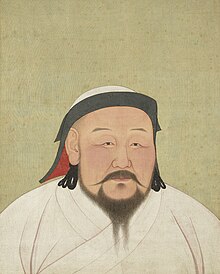Khublai Khan
| Kublai Khan | |||||||||||||||||
|---|---|---|---|---|---|---|---|---|---|---|---|---|---|---|---|---|---|
| 5th Khagan of the Mongol Empire (Nominally due to the empire's division) 1st Emperor of the Yuan Dynasty Emperor of China |
|||||||||||||||||

Portrait of Kublai Khan drawn shortly after his death on February 18, 1294. The painting depicts Kublai prior to the onset of obesity from heavy eating and drinking. Kublai's white robes reflect his desired symbolic role as a religious Mongol shaman. Now Located in the National Palace Museum, Taipei, Taiwan; colors and ink on silk, 59.4 by 47 cm.
|
|||||||||||||||||
| Emperor of the Yuan Dynasty | |||||||||||||||||
| Reign | 5 May 1260 - 18 February 1294 | ||||||||||||||||
| Coronation | 5 May 1260 | ||||||||||||||||
| Predecessor | Möngke Khan | ||||||||||||||||
| Successor | Temür Khan | ||||||||||||||||
| Born | 23 September 1215 | ||||||||||||||||
| Died | 18 February 1294 (aged 78) Dadu (Khanbaliq) |
||||||||||||||||
| Burial | Burkhan Khaldun, Khentii Province | ||||||||||||||||
| Consort | Tegulen Khatun Qoruqchin Khatun Chabi Khatun Dorbajin Khatun Hushijin Khatun Bayujin Khatun Nambui Khatun |
||||||||||||||||
|
|||||||||||||||||
| House | Borjigin | ||||||||||||||||
| Dynasty | Yuan | ||||||||||||||||
| Father | Tolui | ||||||||||||||||
| Mother | Sorghaghtani Beki | ||||||||||||||||
| Religion | Tibetan Buddhism | ||||||||||||||||
| Full name | |
|---|---|
|
Mongolian: ᠬᠦᠪᠢᠯᠠᠢ ᠬᠠᠭᠠᠨ Chinese: 忽必烈 Kublai Setsen Khan |
|
| Era dates | |
| 中統 (Zhōngtǒng) 1260–1264 至元 (Zhìyuán) 1264–1294 |
|
| Posthumous name | |
| 聖德神功文武皇帝 (Emperor Shèngdé Shéngōng Wénwǔ) | |
| Temple name | |
| 世祖 (Shìzǔ) |
Kublai (Mongolian: Хубилай, Xubilaĭ; Middle Mongol: Qubilai) was the fifth Khagan (Great Khan) of the Mongol Empire (Ikh Mongol Uls), reigning from 1260 to 1294 (although due to the division of the empire this was a nominal position). He also founded the Yuan dynasty in China as a conquest dynasty in 1271, and ruled as the first Yuan emperor until his death in 1294.
Kublai was the fourth son of Tolui (his second son with Sorghaghtani Beki) and a grandson of Genghis Khan. He succeeded his older brother Möngke as Khagan in 1260, but had to defeat his younger brother Ariq Böke in the Toluid Civil War lasting until 1264. This episode marked the beginning of disunity in the empire. Kublai's real power was limited to China and Mongolia, though as Khagan he still had influence in the Ilkhanate and, to a significantly lesser degree, in the Golden Horde. If one counts the Mongol Empire at that time as a whole, his realm reached from the Pacific Ocean to the Black Sea, from Siberia to what is now Afghanistan – one fifth of the world's inhabited land area.
In 1271, Kublai established the Yuan dynasty, which ruled over present-day Mongolia, China, Korea, and some adjacent areas, and assumed the role of Emperor of China. By 1279, the Mongol conquest of the Song dynasty was completed and Kublai became the first non-native emperor to conquer all of China.
...
Wikipedia
